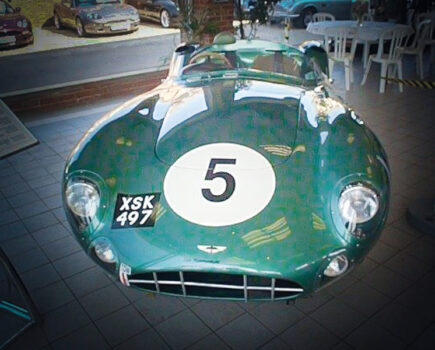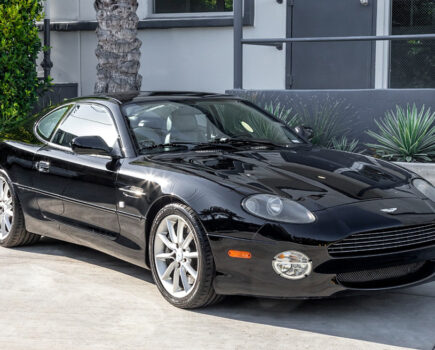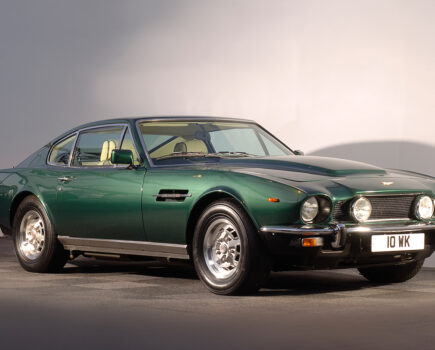The Ford-derived Aston Martin V12 took the firm into the new millennium, powering the DB7, Vanquish and ‘Vertical Horizontal’ cars to stardom
Words: Jon Burgess
A V12 had been on the cards for decades at Aston Martin Lagonda but it took its then-owner, Ford, to finally make the dream come true.
Truth be told, there had been a 4½ litre V12 before the war, but that had been Lagonda’s, designed in part by Walter Owen Bentley; a foil to the majestic Rolls-Royce Phantom III’s 7.3-litre V12, it had been built and tested in record quick time under the auspices of Lagonda’s new owner, Alan Good, who had snatched the marque from the jaws of Rolls-Royce in 1935.
The short-stroke, fast-revving, 60º V12 used Duralumin alloy connecting rods and a nitro-hardened crankshaft without white metal big end bearings, a practice more in common with contemporary aircraft design; displayed as a wooden mock-up at the 1936 Olympia Motor Show, it was made metal the following year and made the 180bhp Lagonda V12 one of the few pre-war British cars that could exceed 100mph, managing 108mph at Brooklands in 1938 with Lord Howe at the wheel. It also had a stated design life of 250,000 miles.
Demand for luxury cars was slowing as 1939 approached, but the Lagonda V12 showed promise as a fast torpedo boat engine when it was trialed in lieu of the incumbent Isotti-Fraschini engines used at the time, although lengthy overhaul times put paid to any chance of a career outside cars.
Two V12s contested Le Mans in a scramble that would become most familiar to post-war Aston Martin in its development of the Tadek Marek V8. Racing exemplified (and improved) the breed, with a third and fourth-placed finish overall. Between 189 and 192 Lagonda V12s were produced across three body styles as late as 1940, with revised ‘Sanction II’ engines making 206bhp.
Of significance was the V12’s creator, and its stylist-designer: WO Bentley, (with help from Stewart Tresilian and gearbox man Charles Sewell) and Frank Feeley.
Bentley’s other Lagonda engine – the 2.6-litre, six-cylinder LB6 – impressed David Brown so much that he bought the firm to gain the rights: that was in 1947, and Frank Feeley became Aston Martin’s stylist-designer for the 2-Litre Sports (‘DB1’) and DB2 series.
The next attempt at bringing an Aston Martin V12 to life came when the Felton firm recruited ex- Auto Union V12 designer Robert Eberan von Eberhorst in 1950; his Type D grand prix car used a 3.0-litre V12. Unfortunately, his DB3 did not perform as expected, which in turn canned any hope of a new V12 commissioned at around the same time; funds had to be spent on making the DB3 competitive, and a V12 was deemed too heavy, complex and time consuming to build.
Although Tadek Marek’s redesigned LB6 and its successor – the Marek six – saw Aston Martin into the 1970s with a stay of execution, it was decided that a V8 offered the best balance of weight, performance and more-than-tolerable refinement; a V8 could better serve the purposes of Aston Martin’s GT cars and racing ambitions.
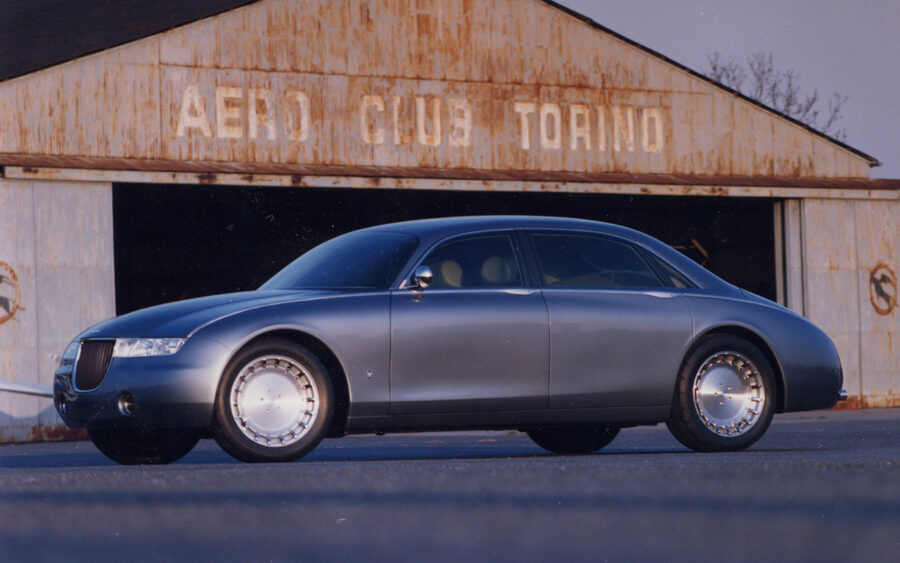
1992 Lagonda Vignale concept
By 1987, Ford had taken a 25 per cent stake in Aston Martin, gaining full executive control in 1992. Finally, a V12 was close to fruition – although it wouldn’t be confirmed until 1993, when Moray Calum’s Lagonda Vignale saloon appeared at that year’s Geneva Motor Show alongside the Aston Martin DB7. The Vignale was billed as a model to revive the moribund Lagonda – a name which only appeared on Works special-bodied Virages and Volantes in penny packet numbers at the time, with the Lagonda Series 5 having left production three years earlier.
Sadly, the Lagonda Vignale didn’t make it into production – but the engine displayed alongside did. Although the unit in the concept car was a mock-up, it was a clear sign of intent from Ford. It had toyed with two V12 engine designs – one based on its Romeo V8, the other using parts from its 3.0-litre Duratec V6.
By the 1996 Detroit North American International Motor Show, Ford had chosen the latter, showcasing the engine in the IndiGo two-seat concept car, built by its Core and Advanced Powertrain Engineering (Advanced Vehicle Technology) department – although it had dyno tested its first prototype in September 1995. At just under 6.0 litres (5,935cc) in displacement, the engine was a clever addition to the Duratec family: it reused the pistons, rings, conrods, valves, valve seats, valve springs and retainers of the 3.0-litre V6, housed within a bespoke block with a new crank, Cosworth-cast heads and double-overhead camshafts.
It would denigrate both engines to say that an AM V12 is simply two Duratec V6s laid end to end; the aluminium used was of a much higher grade (A365-T6) and much work was done on the heads to help the engine run tractably at low revs. New combustion chambers, a higher compression ratio, and ‘tumble port’ intakes designed to help swirl and turbulence, inspired by Jaguar’s AJ16, all went into the design alongside coil-on-plug ignition. The net result was a quoted three-quarters of maximum torque (405lb ft) available at 1000rpm.
The new engine was also stiffer and better braced than the Duratec V6 on which it was based; it also had cross-bolted main bearing caps to boost torsional rigidity. A larger cooling system and oil squirters were also added to cool the pistons during sustained high-speed running.
Ford quoted 435bhp in the Indigo, though development engines managed as much as 600bhp on the dynamometer. By 1997, an agreement had been signed between Aston Martin and Cosworth and the engine was dubbed ‘AM’ for ‘AML V12’ – or ‘SGA’ within Cosworth, which cast the head and the block.
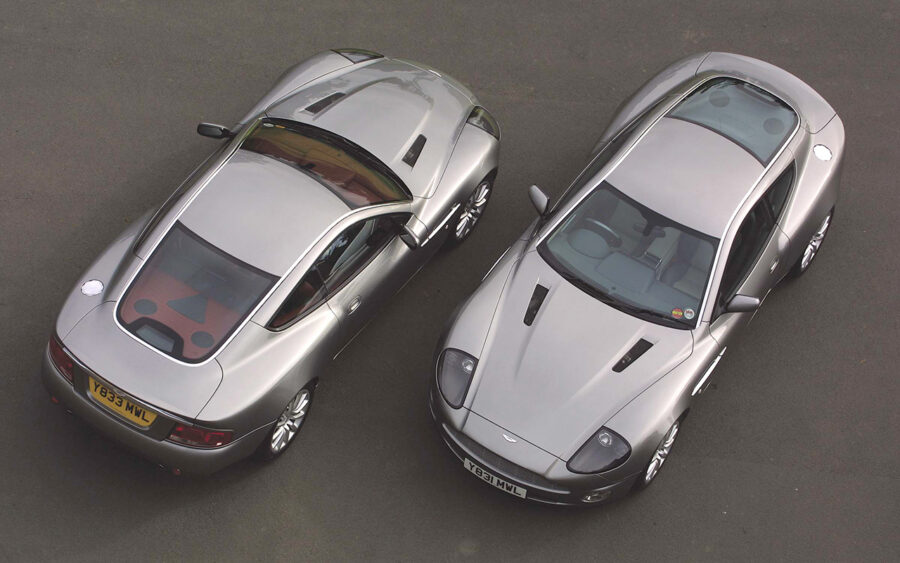
The V12 Vanquish of 2001 made great use of the V12 engine, uprated to produce 460bhp
The V12 made its first public appearance under the bonnet of 1998’s Project Vantage – then billed as a one-off – where a 450bhp power output and a four-second 0-60mph time were claimed.
Of course, it could have been very different. Although the DB7 Vantage of 1999 was the first recipient of the SGA, known as ‘AM2’, three years earlier Tom Walkinshaw of TWR proposed a radically different method of equipping the DB7 with a V12.
Walkinshaw was of course invested in building the DB7 at a facility in Bloxham, Oxfordshire, and had been instrumental in bringing the car to life as ‘Project XX/NPX’, based around the still-born Jaguar XJ41/42 that Ford had canned after taking a dim view as to the programme’s prospects.
Originally, XX/NPX, as Walkinshaw envisioned it, would have been powered by a detuned ex-TWR four-valve Jaguar V12 race engine developed by Al Melling of TVR straight-six and V8 fame. For his V12 proposal, Walkinshaw’s car had a 6.4-litre unit with approximately 470bhp; Walter Hayes, however, Aston’s then-chairman, had insisted on the 3.2-litre, Jaguar AJ6-derived supercharged straight-six that went in the production DB7. Then, as now, it remained a one-off – a fascinating look into how things could have been.
While Project Vantage teased the crowds at the New York International Motor Show, work was proceeding apace to fit the SGA/AM V12 to the DB7, a car which had – to put it bluntly – saved Aston Martin; the Vantage name would appear on the rump of this car first. Much work was done to the shell to help it cope with the output of the V12, including a wider transmission tunnel and a cruciform brace at under the rear differential to mitigate axle tramp. The suspension and brakes were also uprated.
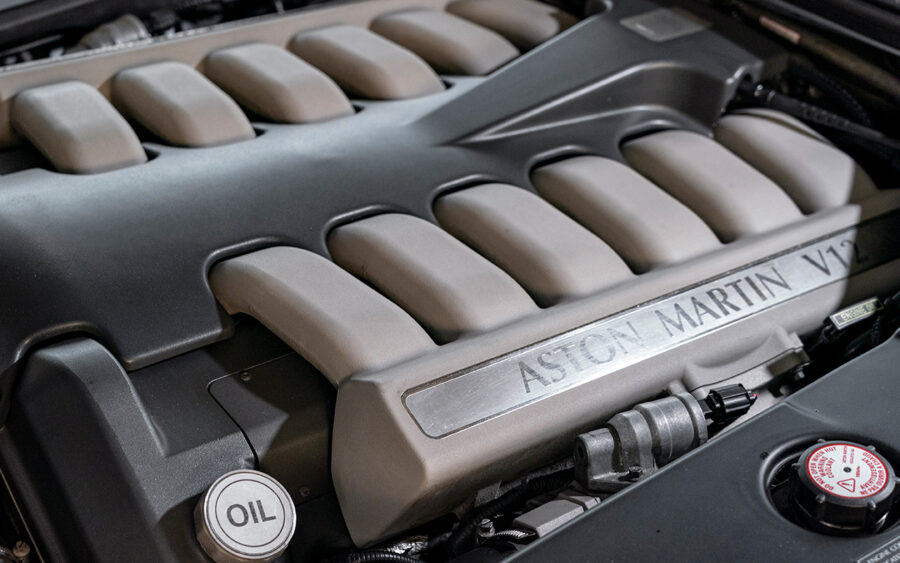
The AM2 V12 in place under the bonnet of the Aston Martin DB7 Vantage
Shoehorning an emissions-compliant AM2 V12 into the DB7 resulted in an engine with a 420bhp peak power output, with 400lb/ft of torque at peak. Thus equipped, the AM2 transformed the prospects of the DB7, with the demand for the Vantage model soon outstripping that of the six-cylinder cars, which were duly discontinued in 2000.
Although power increased slightly to 435bhp with the later GT variants released in 2002, it never matched the peak output of the (460bhp) Vanquish released a year earlier – so as not to embarrass the heavier, more expensive flagship of Aston’s fleet.
A glittering career awaited the V12: it redefined the DB7 in its autumn years, underlined the potential of the Vanquish, and played a key role in determining the appeal of the ‘Vertical Horizontal’ platform cars across four generations. The VH cars met their eventual demise in 2018 with the 14-run Vantage V600 – a nod to the Marek V8 cars killed off nearly two generations prior – owing to changing emissions standards.
The AM V12, as the AM77, did have had one last large-displacement hurrah in 2009 before disappearing into a multitude of ever decreasing V12 Vantage variants: Cosworth reworked the unit extensively into a 7.3-litre monster to power the One-77, a carbon-fibre monocoque-tubbed, aluminium-bodied, 730bhp super GT. By 2015, the Vulcan – the first newly named ‘V-car’ since the 2001 Vanquish – had given the AM a second reprieve. For the Vulcan, a 24-unit, track only special, the AM was taken out to 7.0-litres, boasting 800bhp.
And that should have been it for the AM, between the Vulcan and the Vantage V600 – but another, coach-built variant of the One-77, the one-off Victor, was built after a Belgian customer got in touch. Using a prototype One-77 tub, carbon-fibre bodywork and stylistic call-backs to Robin Hamilton’s RHAM/1 ‘The Grunter’ Le Mans DBS V8, the Victor – named after Aston’s former chairman, Victor Gauntlett – was revealed in 2020; that car had a further-modified AM77, making 836bhp.
The AM V12, twice spared, went out quietly and exclusively, while bellowing; its successor, the AE31, first fitted to the 2016 DB11, was the first production Aston to embrace twin turbochargers.
Since then, another V12, the 6.5-litre Cosworth RA, was commissioned for the hypercar-cum-roadracer Valkyrie; owing nothing to the AM, it took Aston’s fight to the Murray Automotive T.50 and the Mercedes-AMG ONE.
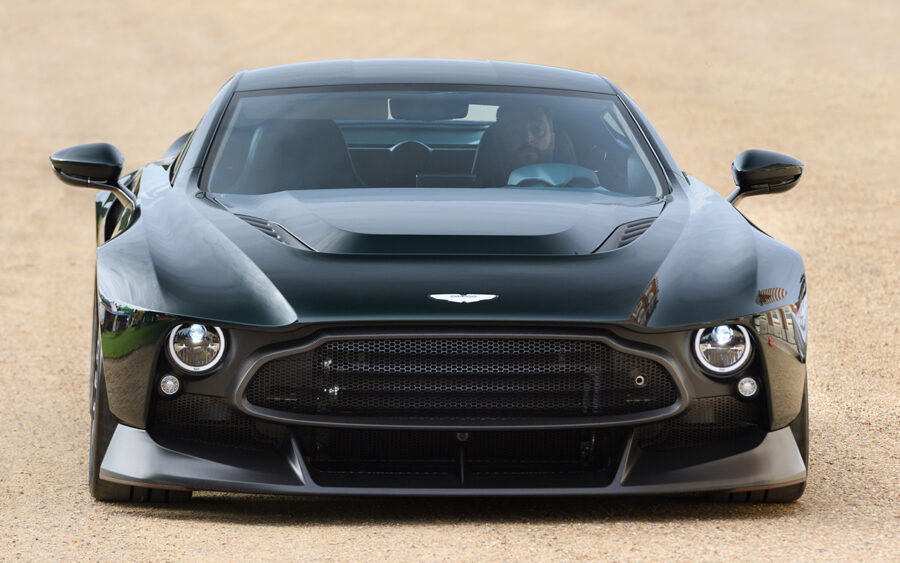
The one-off Aston Martin Victor – a final hurrah for the AM V12 (in modified AM77 form)
Aston Martin AM V12 timeline
1992-1993
Ford gains full executive control of Aston Martin, proposing a V12 for Lagonda in a bid to revive the marque; while the Lagonda Vignale concept goes nowhere, its mocked-up V12 is earmarked for future development.
1994
Ford’s Advanced Vehicle Technology team begins work on the AML V12, selecting Ford’s 3.0-litre Duratec V6 as the basis for its new engine.
1995
First prototypes are dynoed; while many parts are reused from the Duratec V6, the block, heads, camshafts and crank are all unique to the AML V12.
1996
Ford-badged AML V12 appears in the Indigo (IndiGo), a mid-engined concept car built to Indycar dimensions. One running unit is built, with a quoted 435bhp.
Tom Walkinshaw proposes his own DB7 V12, a one-off with a 6.4-litre, quad cam Jaguar-TWR race engine.
1997
Aston Martin and Cosworth sign a deal for V12 engine production; Cosworth to cast and assemble the V12.
1998
Project Vantage, a then one-off concept car, appears with the 5.9-litre (5935cc) AML/SGA V12, now with a quoted 450bhp.
1999
DB7 Vantage launched with SGA V12, now called AM2.
Aston Martin placed into Ford’s Premier Automotive Group (PAG), alongside Jaguar, Land Rover, and Volvo).
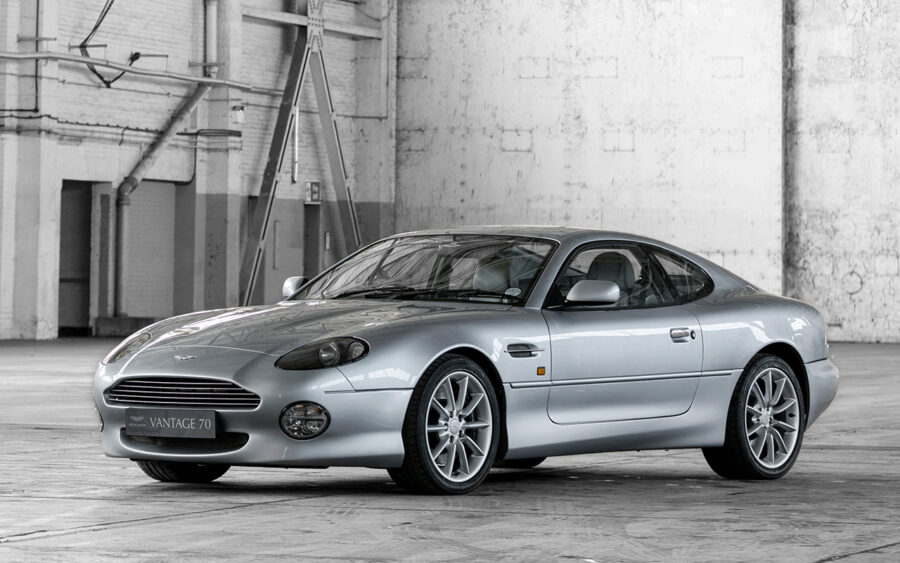
The AM2-powered Aston Martin DB7 Vantage
2001
Aston Martin V12 Vanquish, first new V12 ‘V car’ launched, with 460bhp AM03.
2002
DB7 GT arrives, with 435bhp AM2A; detuned so as not to be faster than the Vanquish. DB7 GTA, with 420bhp V12, also launched.
2004
Aston Martin DB9 launched; 450bhp AM11 V12 fitted.
2005
Vanquish S debuts; new cylinder heads, better engine management and higher flowing injectors up power to 510bhp for the AM06 variant of the V12, finally delivering on the performance promises of Project Vantage, which claimed a 4.0 second 0-60 sprint.
DBR9, built by Aston Martin Racing for the GT1 race category, debuts, using a heavily reworked AM11 but retaining its engine block and cylinder head.
2006–2007
DBS arrives, a direct VH platformed replacement for the Vanquish/Vanquish S. Car appears first in 2006’s Casino Royale; deliveries start the year after; car retains the Vanquish S’s 510bhp AM06 but is designated AM08/AM11 in its new home.
First Lola B08/60s are built with the DBR9’s race V12 based on the AM11.
2008
V12 Vantage deliveries start – a V8 Vantage (2005) variant with the 510bhp AM11 V12 from the DBS fitted.
2009
One-77 enters production, with a carbon fibre monocoque, (Carbon Structure) and an uprated, specially reworked 730bhp AM, known as the AM77.
Lola-Aston Martin B09/60/Aston Martin DBR1-2 Le Mans prototype arrives, powered by a further reworked DBR9 V12.
2010
Four-door Rapide, now VH-based, revives old Lagonda nameplate. AM11 engine fitted initially; 510bhp.
2011
V12 Zagato Stradale appears, with lighter bodywork and AM11 V12.
New Virage unveiled, with AM11 V12.
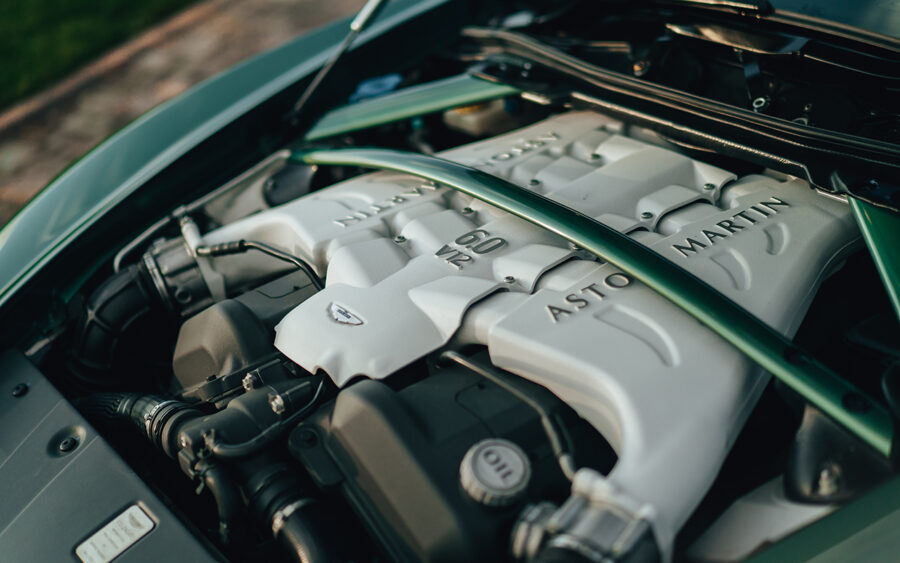
AM11 V12 under the bonnet of the Aston Martin V12 Vantage Zagato
2012-2013
AM28 engined, V12 Vanquish S released, with 565bhp.
Rapide S released, also with AM28, ‘detuned’ to 550bhp.
New Vanquish debuts with AM29 V12.
2014
AM29 now fitted to Vanquish.
2015
Vantage GT12 production confirmed; 592bhp AM28 V12 fitted.
Track-only, 24 unit Vulcan announced with 7.0-litre AM variant, with 800bhp.
2017
Vanquish S arrives with AM29, 603bhp.
2018
Rapide AMR arrives, 595bhp, AM29 now fitted.
Vantage V600 confirmed; 14-run, AM28 under the bonnet, with 592bhp.
2020
One-of-a-kind Aston Martin Victor shown; rebodied, track-only car based on a prototype One-77 carbon fibre tub with a One-77 glasshouse and bespoke carbon fibre bodywork, built by Q Division, using cues from the Vulcan race car, Robin Hamilton’s RHAM/1 Le Mans DBS V8, known as ‘The Muncher’, and named in honour of former chairman, Victor Gauntlett.


